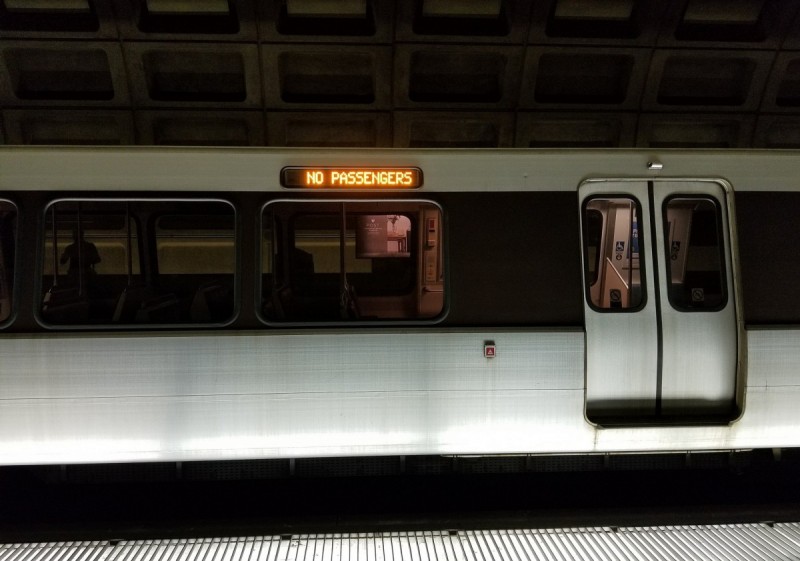Public transit ridership is down in the Washington region (and in other US cities too)

Image by Bryan Alexander licensed under Creative Commons.
Most major US cities have lost significant transit ridership since 2015, according to FTA data. The Washington region has faced its fair share of transit woes in recent years, but as the graphics below demonstrate, it is far from alone (though Vancouver's transit is doing pretty well).
Major cities are seeing ridership losses
Looking at unlinked passenger trips (meaning any trips on transit, where transfers count as additional trips) for 2015-2017, almost all of the 30 largest urban areas in the US lost ridership. In fact, only Seattle, Houston, and Phoenix saw any positive growth, with Seattle showing the most robust gains.
The Washington region saw a large decline in trips between 2015 and 2016 — nearly 8 percent of its volume. The ridership decline leveled off some in 2017, shaving off another three points of its 2015 volume.
FTA Monthly Module Adjusted Data Release. Image by the author.
None of this is good news, but our region still outperformed a number of others. Ten urban areas, including some with relatively high transit use, like Philadelphia and Los Angeles, actually saw greater percentages of losses during the same time period. Neighboring Baltimore barely fared better, with overall losses still above 10 percent.
All and all, the transit losses in major urban areas amounted to 365 million trips, or about 4 percent of the cities’ ridership, in the course of two years. Whereas Washington’s transit slide mellowed in 2017, it actually increased in most other cities.
Subway systems are seeing losses, too
Metro isn’t the only system that has had a rough couple of years. Like the total unlinked passenger trips, only a handful of heavy rail systems managed to gain ridership in the years since 2015. They include the New York Subway, the nearby PATH system, and Philadelphia’s one-line PATCO Speedline.
FTA Monthly Module Adjusted Data Release. Excludes light and commuter rail lines. Image by the author.
The Washington Metro experienced some of the sharpest declines of any heavy rail system — down 12 percent from 2015 levels. Only Baltimore Metro and San Juan’s Tren Urbano experienced greater losses during this time period. (The Tren Urbano system did not operate for nearly three months after Hurricane Maria.)
Does this put Metro in third place?
In February, GGWash Contributor DW Rowlands published an interesting article showing that Metro’s falling ridership knocked it out of the number two spot for subway ridership. Rowlands looked specifically at data from October 2016, so I was curious to see whether this was true outside of this timeframe. The answer: it depends.
FTA Monthly Module Adjusted Data Release. Image by the author.
FTA publishes its annual data for transit systems based off of fiscal years for each different system. So by this metric, Metro remained the second-busiest heavy rail system in 2016.
The problem with this measurement is that the fiscal years for different systems cover different months. WMATA and Boston’s MBTA use a July-June Calendar, while Chicago’s CTA uses a January-December calendar. So to create a better apples-to-apples comparison, I looked at the calendar year data. Indeed, using this uniform timeframe, Metro falls out of second place during 2016 and 2017.
So both the Washington Metro and the Chicago L could probably claim that they are the busiest heavy rail transit system in the country after New York, depending on the measurement. None of this, however, recognizes the fact that both systems have lost a lot of ridership, and another bad year for either could switch up the rankings again.
Buses
Dysfunction on subway systems seems obvious in places like Washington, but bus ridership is not faring much better.
FTA Monthly Module Adjusted Data Release. Image by the author.
What does this all mean?
Pointing to major service changes like SafeTrack seems like a natural reason for transit ridership declines. Regionally, that very well may be true. Nonetheless, trends nationally suggest that cities across the country have been struggling to maintain ridership for the last couple of years.
Whether low gas prices, higher rider wages, poor maintenance, ride hailing services, or other factors are the main reasons for the decreases, SafeTrack probably isn’t the only thing that has been weighing Metro down. It is certainly possible that ridership losses will continue here and nationally. Hopefully local leaders don’t see more service cuts and fare hikes as the solution.
